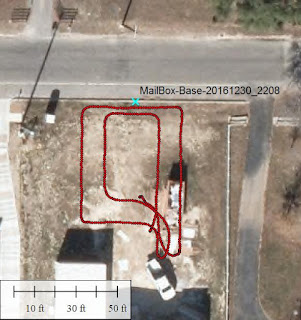Perhaps a simple test example. Recently, this author upgraded his mobile phone -- from a beloved circa 2012/13 Android running Gingerbread 2.3.6 -- to a 2016 ZTE Z981 running Android 6.0.x. Onboard both phones were GPS chipsets -- and the newer ZTE was found to be running a combo GPS-GNSS chipset -- via semi-raw data manifest by SatStat sensor app from the open-source F-Droid repository.
In a recent lunch visit with old client -- the GPS XY accuracy of the ZTE with SBAS arose in tradeoff discussions -- for use in casual field surveys -- verses more expensive L1 and L2 carrier wave and carrier phase tracking systems. Too much to explain here -- perhaps a diagram to tease the curious as we move onto simple results:
GPS Carrier wave & code modulation.
Inphase & Quadrature signal combos
(from wikipedia)
FIELD TEST: Rather than waste time searching for ZTE Z981 GPS-GNSS chipset hardware specs -- and believing the published accuracy claims -- it was just easier to collect a herd of static positions -- and plot on aerial photo.
So one nice afternoon -- while writing a technical proposal -- the ZTE Z981 was setup to log static GPS-GNSS observations from under moderate tree canopy -- and inside a Gazebo with polystyrene tarp roof (i.e. almost 100% transparent to GPS signals at approx 1500 mhz). The ZTE phone-GPS was set on a metal "garden table" that acted as RF ground plane and block some ground bounce multipath.
To log observations, this author downloaded a GPS-GNSS app called uLogger from the F-Droid repository. uLogger has the ability to set 10 sec GPS-GNSS observations -- and ignore any internal accuracy tests. And uLogger exports to open-source, easy to read-convert GPX exchange file format. (download the GPX file ).
RESULT -- Collected 881 GPS-GNSS observations -- using "code only" and with SBAS corrections. Plotting on local aerial photo -- with 10 and 20 meter range rings resulted in this plot:
881 GPS-GNSS observations at 10 sec intervals
Collect from author's yard Gazebo and plotted
over recent aerial photos. Scale rings are 10 and
20 meters from approx "average" center.
Good? Bad? Ugly? How does this compare? To circa 1999-2000 GPS hardware? Pictures are worth 1000s of words -- and digging thru the archives -- compares with 1996 Garmin 12XL ($600 at time) -- and a $12,000 L1-L2 tracking Novatel.
Garmin 12XL and approx 24 hours of GPS observations
at 4 sec log interval. Range rings are 100, 200 & 300
meters. Large elliptical loop patterns are examples of
pre-May-2000 deliberate GPS accuracy degradation
Circa 1996 Novatel L1 & L2 in "free float" mode
(i.e. no differential corrections). 24 hours of 4 sec
interval observations collect from same antenna
location as Garmin 12XL. Note scatter plot vs 100
-200-300 meter range rings -- and how the Novatel
was able to "computationally resist" the degradations
and deterministic elliptical loops of selective availablity.
SUMMARY -- Upshot? The ZTE Z981 is approx $100 USD smartphone. The GPS-GNSS chipsets beat -- hands down -- much more expensive GPS hardware from late 1990s. With care and practical use understanding -- even "simple" smartphone GPS-GNSS hardware can be used to collect XY mapping data for certain types of surveys.




















